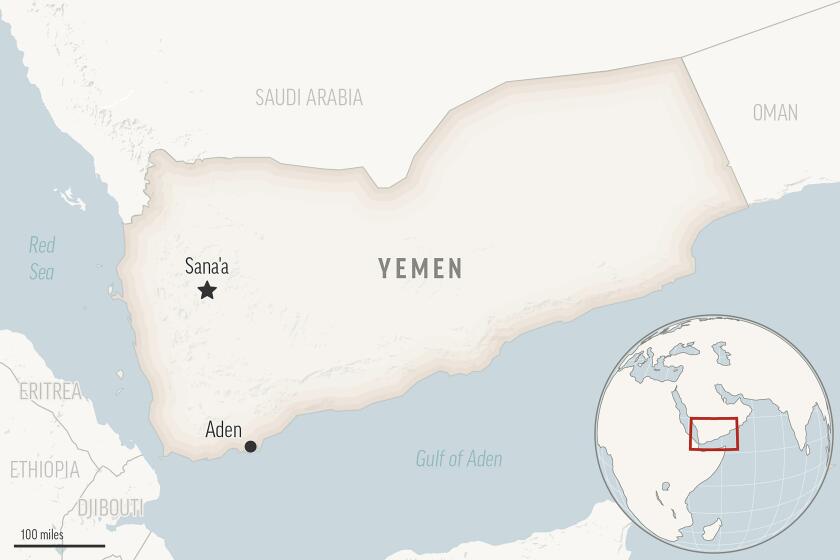Los Alamos Gets to the Core of Dismantling Nuclear-Weapon Stockpile
- Share via
LOS ALAMOS, N.M. — They go in looking like bombs and come out looking like beer cans. Deadly beer cans.
Rattling around inside each can is a hockey puck-size disk of plutonium--the lethal remains of a nuclear bomb.
The United States and other countries that for years stockpiled weapons of mass destruction are now having to figure out ways to destroy massive numbers of those weapons.
Congress last month ratified START II, which mandates reduction of stockpiles in the United States and the former Soviet Union from an estimated 55,000 four years ago to about 3,500 nuclear weapons apiece by 2003.
The politics of reducing national arsenals are complex. But scientists say those negotiations are far simpler than the technical challenge of dismantling nuclear weapons.
“It is incredibly complicated to handle plutonium and package it for long-term storage. If too much gets too close together, it can spontaneously start a nuclear reaction,” said Jim Toevs, who is in charge of nuclear materials disposition at Los Alamos National Laboratory.
In November, the lab and the U.S. Department of Energy invited reporters for a first glimpse of the Advanced Recovery and Integrated Extraction System, or ARIES, a $30-million project to design and produce a machine for dismantling nuclear bombs.
“We’ve long said we handle plutonium from cradle to grave here. ARIES is the means by which we put these weapons to bed,” said Joe Martz, a weapon component technology group leader at the lab.
Fifty years ago, Los Alamos researchers designed the world’s first atomic weapon. Since then, tens of thousands of nuclear weapons were designed, produced and maintained throughout the world.
In the United States, components were built in different states and assembled into weapons at the Pantex plant in the Texas Panhandle.
Pantex workers now are dismantling most of the estimated 20,000 nuclear warheads the United States owned when the Cold War ended in 1992.
Most of what was once a nuclear bomb is crushed beyond recognition to prevent national secrets about the weapons from falling into the hands of terrorists. Gold and other precious materials are recycled and sold.
But the pits--spherical sealed containers with plutonium inside at the heart of each weapon--cause the most consternation.
“That’s the big question: What do we do with all those pits?” said Bart Flamm, an ARIES researcher at Los Alamos.
In the 1980s, pits were sent to the Rocky Flats nuclear weapons plant near Denver, where the plutonium was leached out by acid in a process that produced unwieldy amounts of radioactive liquid waste.
For environmental and safety reasons, Rocky Flats was closed in 1989. These days the pits are stored in World War II bunkers near Pantex with doors so thick they don’t even use locks. Inside the pits, the plutonium is disintegrating.
Flamm is part of an elite team of 30 researchers who have designed ARIES--the all-in-one nuclear bomb disarming machine that can flip pits upside-down, pry open one end, and inject hydrogen gas.
The gas turns the plutonium into a powder that filters down into a crucible where it is melted into an ingot. The ingot is welded into a canister that is then filled with helium.
*
The entire process is completed within a large box. Workers stand outside of the box and use gloves hermetically sealed to the exterior to reach inside.
“It’s a project that starts with a pit and winds up with material plutonium packaged for long-term storage,” Toevs said.
ARIES was recognized by R & D Magazine as one of 1995’s 100 most significant technological innovations in the world.
So far, project workers have cleaned plutonium out of 30 pits in one year. Eventually, they hope to have their technology mounted onto a tractor-trailer and taken to Pantex and to Russia, where one pit a day could be reduced to a pile of scrap metal and a canister of plutonium.
Another advantage of ARIES is that it shifts plutonium from a classified shape to an unclassified one.
Even pits that are in good enough condition to store cannot be inspected by members of the Vienna-based International Atomic Energy Commission, who are supposed to verify START compliance.
After they’ve been through ARIES, the sinister portion of the pit looks as innocuous as a can of beer--without the label.
In addition, ARIES makes the dismantling of the bomb final. When pits are stored intact, Toevs said, there remains a possibility they could be reused. But the puck-like pieces are almost impossible to recycle back into a weapon.
The Energy Department reports that ARIES will cost about $14 million this year and another $14 million in 1997. In 1996, about $10 million of the ARIES funding will go to the Los Alamos lab--$5.6 million in operations and $4.3 million in capital. An additional $3.8 million will go to Lawrence Livermore National Laboratory in California, and at least $100,000 will go to Sandia National Laboratories in Albuquerque.
ARIES researchers say that’s a small price to pay to solve one of the world’s greatest threats.
“Here’s an opportunity to help make the world safer,” Toevs said.
More to Read
Sign up for Essential California
The most important California stories and recommendations in your inbox every morning.
You may occasionally receive promotional content from the Los Angeles Times.













